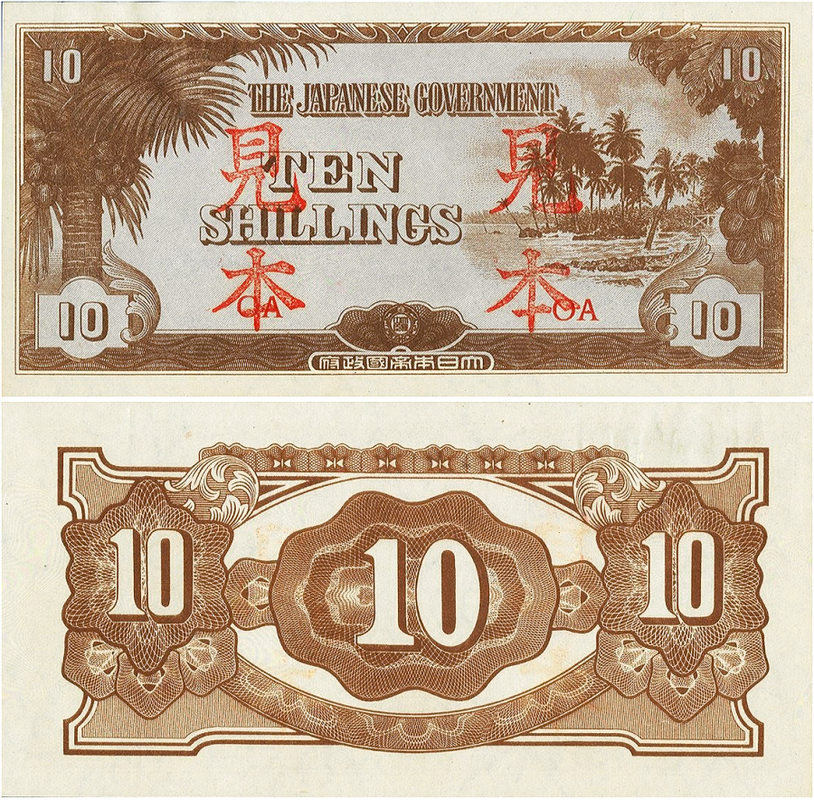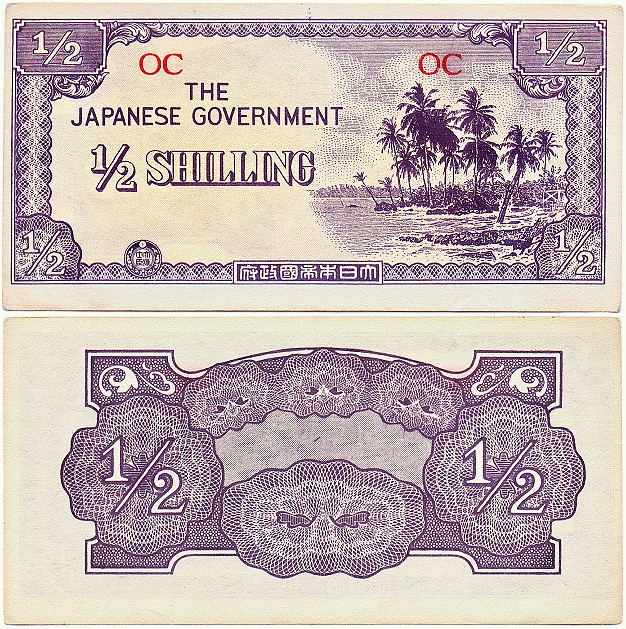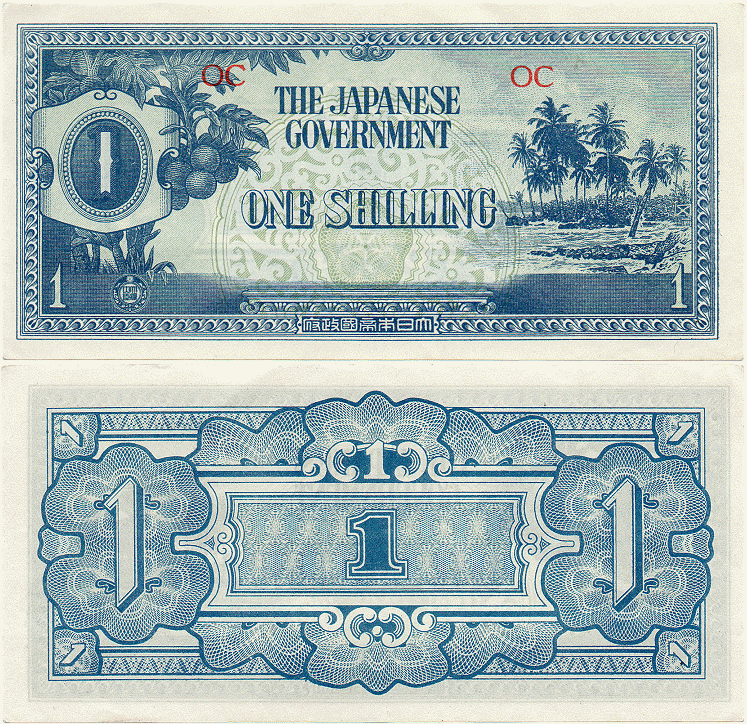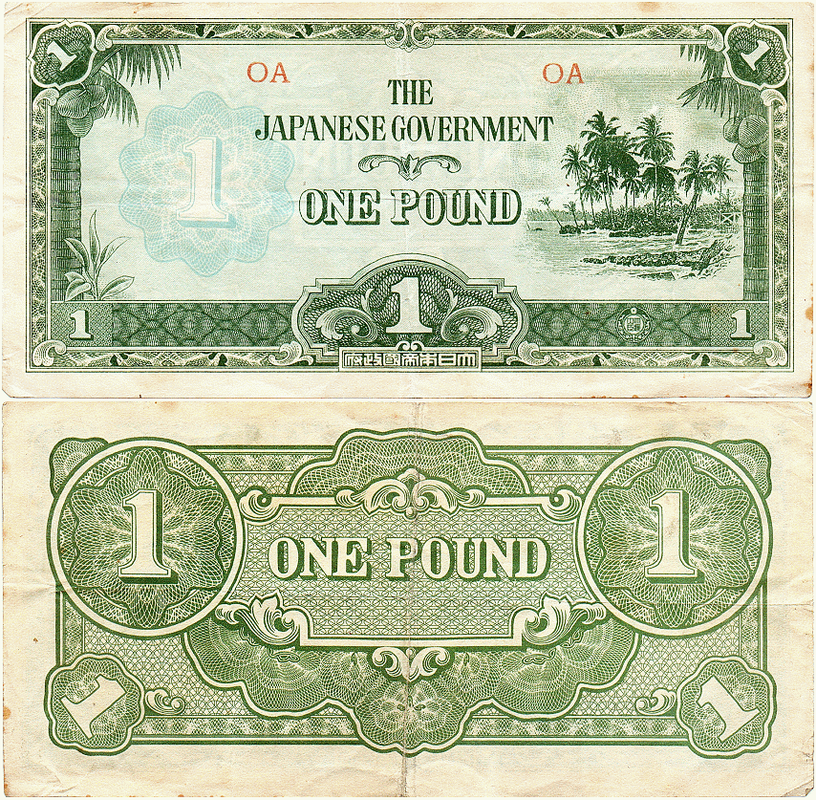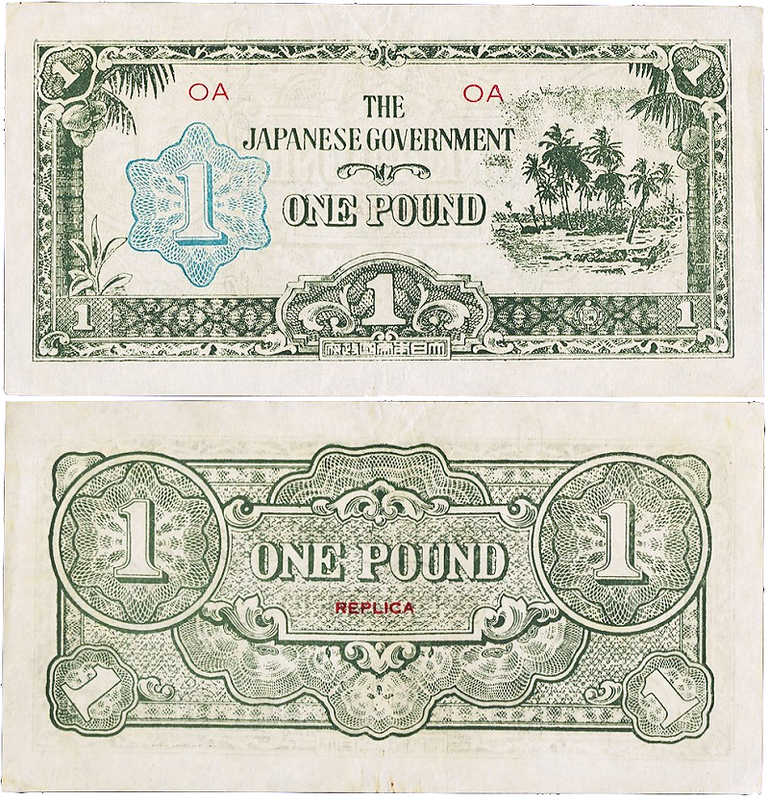The Japanese Occupation of 'O' Oceania |
(updated September 10, 2016)
|
The Oceania Japanese occupation shilling and pound notes were issued for use in Australian mandated territories throughout British Oceania (principally Gilbert and Solomon Islands, New Britain and Papua New Guinea). This occupation pound was issued utilising the Australian pound as the basic monetary unit, hence the rise in rumours that their production indicated Japan's intention to invade Australia. This is not however what these notes were intended for. These are the least common series of the circulating Japanese 'Invasion' money issues (JIM), more correctly 'occupation' money, as fewer were printed due to limited need in a scattering of mostly sparsely populated Pacific islands.
Early replicas of c1943 and later printed in Australia are more valuable than the genuine notes. These are often, though not always marked 'replica' in red. Even unmarked they can be easily picked out from genuine Japanese issues or less collectible modern counterfeits. The series of replicas included the 1/2 Shilling, 1 Shilling and 1 Pound, produced in Australia from 1943 until after the war. No replicas of the 10 Shillings were made, probably as few of the original notes were produced an example may not have been available to copy.
The Commonwealth Bank of Australia was notified of these forgeries during 1943-44 and launched an investigation. Whilst it was concluded that no law was being breached it was decided that the continued production and sale of these notes was "undesirable", and that measures had to be taken to further prevent such. All known stock for sale in Sydney was obtained (43 replicas of the 1 Pound) and deposited at the Bank. No further action seems to have been taken.
It was determined by the bank that some of these notes were produced by the Economy Printers Pty Ltd for the Bulldog Casket Shop in Brisbane and overprinted 'replica', however unmarked notes (such as the 1 Pound example below) were printed elsewhere by an as yet unknown printer. The reported 1/4 Shilling note only exists as a fantasy and was never issued by the Japanese.
The details for identifying the period Allied/Australian government counterfeits are not yet known.
The Money
1942
|
The Japanese text which appears in the lower border of every banknote translates as "The Government of Great Imperial Japan". The small circular seal found nearby is of the Ministry of Finance. Specimens: right: notes overprinted with 見本 ('mi-hon') are specimens. Apparently - this has yet to be confirmed - but genuine specimen notes are not truly "overprinted", but have the mihon characters printed on the paper before the banknote design is added, so that they are in effect an underprint. Many genuine notes but with fake mi-hon 'overprints' have appeared in recent years. |
|
'1/4 Shilling' (fantasy)
This only appears as a post-war fantasy piece and was never issued by the Japanese. It was adapted from the 1/4 Rupee for Burma, and was probably produced in the 1960s-1970s by the same printer responsible for mono-colour printings of the 1 Shilling and 1 Pound notes (see under 1 Pound, below). Undated, as source. Yellow. (front) text and amount. (back) numerical amount and patterned borders. Watermark: none Printer: private Type 1 (SCWPM unlisted) Block serial: none (at least with this example). |
|
1/2 Shilling Undated (known to have been issued from January-March 1942). Colour tone varieties. Purple. (front) palm trees, beach, at right. (back) numerical amount and patterned borders. The same basic design as used across the 50 cents, cantavos, half gulden, half rupee issues. Watermark: quatrefoil kiri flower Printer: Japanese Government Type 1 (SCWPM 1b,c) Block serial: OA-OC. Block 45mm apart. Type 2 (SCWPM 1a) Block serial: OC. 35mm apart. Type 3 Specimen Type 4 1940s Australian replica(s). Examples with (right) and without 'replica' printed on the back. (SCWPM Oceania R1) Type 5 Allied forgery |
|
1 Shilling Undated (known to have been issued from January-March 1942). Two paper varieties (woven or plain). Blue. (front) Breadfruit tree at left, palms at right. (back) numerical amount and patterned borders. The note design reuses the same basic design as the Malaya 1 Dollar. Watermark: quatrefoil kiri flower Printer: Japanese Government Type 1 (SCWPM 2a) Block serial: OA-OC. Type 2 Specimen: 2 types; large red overprint, or smaller red overprint with 'specimen' on the back. Type 3 1940s Australian replica(s) (below); with or without 'replica' stamped on the back. (SCWPM Oceania R2) - with green underprint (not shown). (SCWPM Oceania R3) without a real underprint (below). In the lower example someone has tried to obliterate the 'replica' overprint; ironic as these replicas are more valuable than the genuine note. Contrary to the SCWPM, R3 clearly are found with the 'replica' overprint. Type 4 Allied forgery |
|
10 Shillings Undated (known to have been issued from January-March 1942). This was never reproduced in replica form by the Australians, possibly because they had no examples to copy from as this is the scarcest of the denominations. Brown. (front) Coconut palm tree at left, scene of palms, and paw-paw tree; at right. (back) numerical amount and patterned borders. The 10 Shilling is a hurried adaptation of the plates used for the 5 Dollar/Gulden notes of Malaya and the Netherlands Indies. Unlike these however the note only has a simple front underprint of wavy lines, and the added numerals '10' are noticeably crude and hurried - especially the large numerals on the back of the note. Watermark: quatrefoil kiri flower Printer: Japanese Government Type 1 (SCWPM 3a) Block serial: OA. Type 2 Specimen: smaller red overprint with 'specimen' on the back. Type 3 Allied forgery? |
|
1 Pound Undated (known to have been issued from January-March 1942). Green. (front) seed pods, and the usual palm trees scene at right (back) numerical amount and patterned borders. The 1 Pound is an adaptation of the Burma 10 Rupees, P 16. A version of the same underprint guilloche is used, as well as the titles. Both the Oceania and Burma issues share the same extra seed pod hanging from the right border tree on the front. Curiously however the third pod is different, being larger on the Burma issues. This difference seems to indicate that the extra pod was a last-minute revision of the designs. These features would also seem to indicate that the Burma and Oceania series were designed later than that for Malaya and the Netherlands Indies. Watermark: quatrefoil kiri flower Printer: Japanese Government Type 1 (SCWPM 4a) Block serial: OA. Type 2 Specimen: 3 types, red overprint with or without 'specimen' on the back, some hole punched. Type 3 1940s Australian replica(s): two main varieties are known: with 'replica' printed in red on the back (SCWPM Oceania R4, right), or without 'replica' (as the example shown, lower-right, SCWPM Oceania R5) and in three varieties of green printing. The tone of the blue guilloche and the font used for the block serial 'OA' differs between the two main types. The pale blue guilloche is of a different design to that used on the genuine note. Type 4 c.1960-1970s printing in mono-colour; apparently the same series-printer responsible for the 1/4 Shilling 'fantasy' note (see above). US origin? (example: right)
Type 5 Allied forgery (right) - an example of a suspected forgery. The block letters are unusual when compared with other examples, and more importantly there are differences to the engraving as shown in the comparative close ups: the wavy left side of the seed pod and other differences in form and direction of the lines.
|
